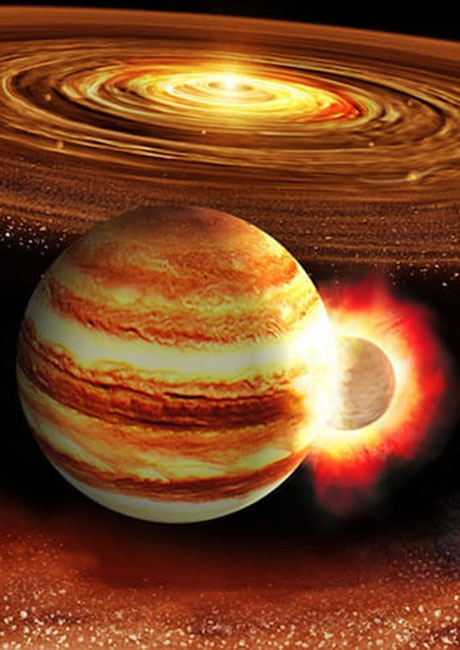|
by Andy Lloyd from AndyLloyd Website
Spanish version K. Suda & Y. Akimoto/Mabuchi Design Office, courtesy of Astrobiology Center, Japan
Its reliance upon a hefty planetary collision runs against the general grain of thinking, because such events are usually considered to be only remotely possible, on a statistical level. (1)
Nonetheless, the evidence
emerging from the spacecraft Juno's exploration of Jupiter indicates
that something very significant disrupted the gas giant's core early
on. (2)
Something appears to have disrupted it early on - an event which had lasting consequences across the lifespan of the solar system. Cast your mind back to the impact of Shoemaker-Levy comets, and the grazing blows that the fragmented comets caused across Jupiter's upper atmospheric layers.
In no time at all, the giant planet returned to its normal appearance, although the impacts caused substantial changes within.
To disrupt the core itself, the impact would have to impact the planet's core itself - a direct hit by a body massive enough to survive the deep penetration necessary through Jupiter's deep atmosphere.
Not only would the impactor need to hit the central bulls-eye, it would also need to remain intact through its descent.
A planet about 10 times Earth's mass would be sufficient to the task, computer modeling suggests: (2)
The internal disruption to Jupiter would take literally billions of years to overcome.
Even 4.5 billion years on, the giant planet is still in a pickle deep down, Juno's data suggests.
...it seems as though planetary collisions were the norm in the early solar system.
The researchers involved in this work think that these kinds of catastrophic events may be more common than previously thought.
The immensity of these collision events may explain heat flares around young stars, where some of the starlight has been temporarily affected up by immense post-collisional debris fields orbiting the star. (1)
Other scientists may be skeptical of these claims (even though they are backed up by some strong sets of numbers), but this new hypothesis may prove to have good predictive powers.
More so, it illustrates
the very chaotic nature of the early solar system, and the high
potential for planetary collisions during that time.
|


